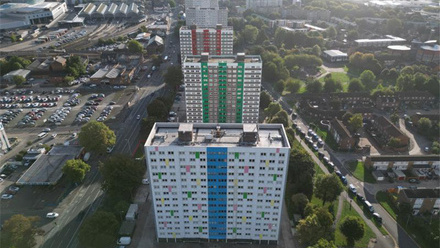Building safety regime in Wales will apply to all buildings of two or more homes
Julie James said in a statement:
It is our intention to go significantly further than the [regime] introduced in England via the Building Safety Act 2022.
Any exemptions to the rules will be laid out in legislation at a later date.
She also extended the deadline for building inspectors to be registered with the Building Safety Regulator (BSR) from 6 April to 30 September after "listening to concerns" over the timeframe.
The minister said the Building Safety Programme in Wales will focus on both the issues posed by external cladding and on internal fire safety issues.
The programme has been developed as part of Welsh Labour's co-operation agreement with Plaid Cymru. Senedd officials have consulted a range of stakeholders, including tenants, homeowners, housing chairs and local authorities in creating the new system.
Management consultancy Adroit Economics has been commissioned to undertake an economic examination, including a cost-benefit analysis, of the proposals. Once the cost and resourcing implications on councils are more clearly understood, officials will develop a plan to support a transition period.
In July, the Welsh government confirmed that all housebuilders that signed up to the developers' pact to remediate buildings with fire safety issues have set out plans for completing the work, despite concerns raised by a resident group.
James said:
Lessons from the Grenfell tragedy highlighted the need for clear accountability in relation to those who own and manage relevant buildings.
The Building Safety (Wales) Bill will establish a robust and coherent regulatory system, creating clear lines of accountability, imposing a range of statutory duties on relevant 'duty-holders' in respect of the relevant parts of a multi-occupied residential building.
Work is also under way to reach out to smaller developers that fall outside the terms of the developers' pact, with the Welsh government committed to providing support to developers that cannot cover the full cost of works.
Any building whose developer has ceased trading or is not identifiable for any reason will fall under the responsibility of the government.
James added:
Eleven major developers have signed up to our contract so far. I am disappointed, however, that Watkins Jones are yet to sign our contract. I do not consider this acceptable.
I have made it clear, and will do so again when I meet Watkins Jones, that I will consider all options available, including prohibitions on development, to ensure developers step up to their responsibilities.
We are working with other developers, understanding we all have a common interest in putting right fire safety issues and knowing the reputational damage of not doing so swiftly.
A joint inspection team will be established to support local authorities and fire and rescue services in undertaking additional inspections of high-risk buildings, as well as providing advice on building control, environmental health, fire engineering and rescue services.
This team is expected to undertake its first inspection at the start of the financial year and will prioritise buildings where the owners have not yet submitted an expression of interest to the Welsh government's Building Safety Fund.
This article first appeared on Inside Housing





